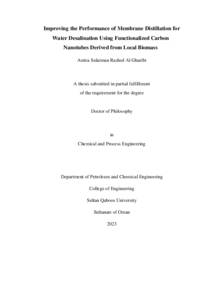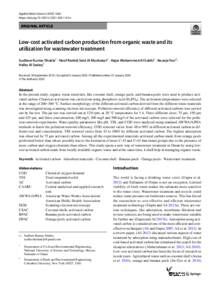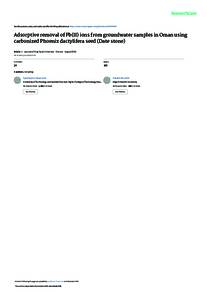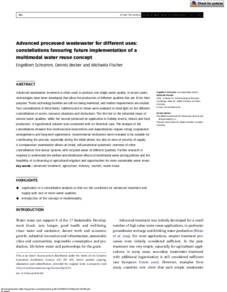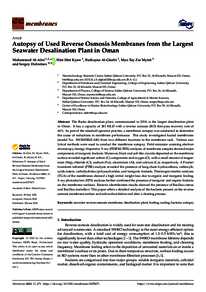Document
Improving the performance of membrane distillation for water desalination using functionalized carbon nanotubes derived from local biomass
Publisher
Sultan Qaboos University.
Gregorian
2023
Language
English
English abstract
The rising burden on the issue of water scarcity necessitates a cost-effective, efficient
water treatment technology in order to provide high-quality clean water and meet
global water demand. Membrane distillation (MD) is a relatively new alternative
separation method that may be utilized for desalination. This technology is promising
to replace currently dominating pressure driven membranes-based desalination
methods. However, most of current studies aim at improving the MD membrane in
terms of cost, durability and salt rejection. This work attempts to address some of the
bottlenecks concerning the commercialization of these membranes in the desalination
industry by focusing on the utilization of cheap raw materials for the synthesis of
nanoparticles and the membrane. Functionalized Carbon Nanotubes (f-CNTs) were
derived from local waste biomass and utilized as an additive to improve the efficacy
of the membrane used in an MD unit configuration.
Local waste date palm stems (Phoenix dactylifera) were used to prepare activated
carbon (AC) using KOH and two metal chloride salts (NaCl and ZnCl2) as activation
agents. The carbonization was conducted at 600 oC for 2hr under nitrogen flow,
followed by activation at 750 oC for 2 hr under carbon dioxide gas flow. AC was
characterized using a scanning electron microscope (SEM), Attenuated total
reflectance Fourier transform infrared (ATR FT-IR), Thermogravimetric analysis
(TGA). In addition, surface morphology was characterized by Iodine adsorption and
Brunauer-Emmett-Teller (BET), at different carbon-to-activation-agent-ratios. FTIR
spectra results showed a reduction in AC-NaCl bands compared to other AC, which
indicates less functional surface groups. At 750 oC, the TGA analysis showed that
carbon yield as AC-ZnCl2 > AC-NaCl > AC-KOH. However, among all samples, AC NaCl at 1:2 ratio was the best in terms of iodine removal. This treated AC sample
exhibited about 18.3 % maximum iodine removal, which indicates the high surface
area and porosity with 550.44 m2
/g, 348.74 m2
/g, and 201.69 m2
/g BET, micropores
and mesopores surface areas, respectively. In conclusion, the local Omani date palm
waste stems can be used for AC production with a well porous structure using cheap
and environmentally friendly salts as activation agents. Furthermore, the produced AC
attained better adsorption characteristics among other alternatives.
The current work addresses the utilization of AC as a supporting substrate combined
with NaCl as a novel green catalyst for the synthesis of carbon nanotubes (CNTs) via
a catalyzed chemical vapor deposition (cCVD) method. The effect of different AC NaCl ratios on CNT growth was investigated. The nano-particle yield was estimated
and samples were characterized by BET, Electron microscopy (SEM and TEM), XRD,
FTIR, and TGA analyses. The asymmetrical porous structure and high surface area of
the AC clearly offer excellent uniform NaCl dispersion properties on the surface,
resulting in a high catalyst-transition metal free-yield of CNTs forest growth. The
results showed higher mass yield in the order AC-NaCl 1:2 > AC-NaCl 1:1 > AC NaCl 1:3 ratios. AC and NaCl are excellent choices as substrate and catalyst
combinations for the synthesis of metal-free MWCNTs as they are cost-effective and
environmentally friendly.
Acid functionalization was conducted using an acid mixture of H2SO4:HNO3 at
different volume ratios to improve the CNTs dispersity and to eliminate contaminants
from their surfaces. Functionalized carbon nanotubes (f-CNTs) were then employed
to prepare composite membranes for saline water desalination via direct contact
membrane distillation (DCMD). Different f-CNT loadings were tested. All produced
membranes were subjected to various characterization tests including porosity, SEM,
ATR-FTIR, TGA, Contact Angle (CA) and Tensile strength tests.
The results showed that the inclusion of f-CNT structure could improve
hydrophilicity, porosity, thermal stability, and mechanical strength of the composite
membranes. The DCMD process was also improved using f-CNTs compared to other
membranes as the f-CNTs offered additional pathways for water vapor transport. In
the DCMD experiments, the highest permeate flux reached was 19.6 kg/m2
.hr and >
99% salt rejection at 80 oC feed and 20 oC permeate temperature. This was achieved
with 78.8o
contact angle, 56% porosity and thermal stability higher by more that to 11
°C compared to pristine PVDF. Overall, the results show that PVDF-f-CNTs
membranes offer a potential and encouraging alternative to existing membranes.
Central composite design (CCD) was applied to analyze and optimize the
performance of PVDF-f-CNT 0.03% membrane. CCD is the most common design
used in response surface method (RSM). The MD performance was modeled using
the quadratic regression model as a function of the operating conditions (feed
temperature, flow rate and concentration) was studied. Feed temperature had higher
x
impact on vapor flux for DCMD compared with the other variables as it was the most
significant factor (p-value < 0.05) followed by feed flow rate (p-value =0.0830). On
the other hand, feed concentration had the least effect on the flux (p-value =0.1683).
Increasing feed temperature improves the evaporation rate in the feed side which
consequently creates higher vapor pressure difference, therefore, improving MD flux.
Optimization of operating conditions was conducted to maximize permeate flux
within the range. A desirability of 0.776 was achieved at a feed temperature of 80 oC,
feed flow rate of 75mL/min and 0.4 M feed concentration in which a flux of 19.472
kg/m2
.hr was obtained. Another optimization study was conducted at wider ranges and
maximum flux of 31.078 kg/m2
.hr could be found at 90 oC feed temperature,
80mL/min flow and 0.4 M NaCl feed concentration. A permeate flux of 29.7 kg/m2
.hr
was achieved by the validation experiments, which indicates the reasonable accuracy
of the predicting model.
The inclusion of waste-biomass-based carboxylated CNTs increased the MD process
performance by enhancing the interactions between water and the membrane and
boosting vapor permeability while preventing liquid from penetrating the membrane
pores. This work contributes in paving the way for enhancing the MD process
performance and promoting its commercial application potential.
Member of
Resource URL
Arabic abstract
من أجل إنتاج مياه نظيفة عالية الجودة و تلبية الطلب العالمي للمياه، فإن الضغط المتزايد على قضية نقص المياه يستلزم إلى حد كبير تكنولوجيا معالجة مياه فعالة من حيث التكلفة والفعالية. التقطير الغشائي هي عملية فصل، حرارية، يمكن إستخدامها في تطبيقات تحلية المياه. هذه التكنولوجيا الواعدة يمكن أن تحل محل طرق تحلية المياه القائمة على األغشية القائمة على الضغط. تهدف معظم الدراسات الحالية إلى تحسين غشاء التقطير الغشائي من حيث التكلفة والمتانة وكفائة رفض الملح. يحاول هذا العمل معالجة بعض العوائق المتعلقة بتسويق هذه األغشية في مجال تحلية المياه من خالل التركيز على إستخدام مواد خام رخيصة لتخليق الجسيمات النانوية و من ثم صناعة األغشية . في هذا العمل تم تعزيز فعالية التقطير الغشائي لتحلية المياه من خالل استخدام األنابيب النانوية الكربونية الوظيفية (CNTs-f (المشتقة من كتلة حيوية محلية واستخدامها كإضافة لتحسين فعالية الغشاء المستخدم في تكوين وحدة التقطير الغشائي. تم استخدام سيقان نخيل التمر المحلية (dactylifera Phoenix (لتحضير الكربون المنشط باستخدام KOH واثنين من أمالح كلوريد المعدن كمواد تنشيط. تم إجراء الكربنة للمادة الخام عند 600 درجة مئوية لمدة ساعتين تحت تدفق غاز النيتروجين، تليها عملية التنشيط عند 750 درجة مئوية لمدة ساعتين تحت تدفق غاز ثاني أكسيد الكربون. الناتج من علميات التصنيع تم تحليله باستخدام اإلجهزة التاليه : SEM ، TEM، IR-FT ATR، و TGA . باإلضافة إلى ذلك ، تحليل مورفولوجيا السطح بامتصاص اليود و Teller-Emmett-Brunauer (BET(. تم دراسة النواتج باستخدام نسب مختلفة من وزن الكربون إلى وزن عامل التنشيط .أظهرت نتائج مقارنةً ربون النشط األخرى، مما يشير إلى أطياف IR-FT انخفا ًضا في نطاقات NaCl-AC بعينات الك مجموعات سطح وظيفية أقل . عند 750 درجة مئوية، أظهر التحليل الحراري الوزني (TGA (أن ترتيب إنتاج كميات الكربون كما يلي : KOH-AC> NaCl-AC> 2ZnCl-AC . ومع ذلك، من بين جميع العينات، كان NaCl-ACبنسبة وزن :1 2 األفضل من حيث امتصاص اليود. حيث امتص حوالي ٪18.3 من اليود، مما يشير 2 إلى مساحة سطح مرتفعة ومسامية عالية: 550.438م 2 / جم BET ، 348.743 م / جم مسامات دقيقة ، و 2 201.695 م / جم مساحات سطحية متوسطة. النتائج تثبت انه يمكن استخدام سيقان نخيل التمر العمانية إلنتاج كربون منشط بهيكل عالي المسامية باستخدام أمالح رخيصة وصديقة للبيئة كعامل تنشيط. عالوة على ذلك، حقق الكربون النشط المنتج خصائص امتصاص أفضل من بين البدائل األخرى المستخدمة . على الرغم من حقيقة أن العديد من تقنيات األنابيب النانوية الكربونية (CNTs (القابلة للتطبيق قد تم تأسيسها على مدى العقود القليلة الماضية، إال أن استراتيجية تصنيع أنابيب نانونيه كربونية خالية من المعادن لم يتم دراستها بشكل كبير حتى اآلن. يتناول العمل الحالي استخدام الكربون النشط كركيزة داعمة مقترنة مع ملح كلوريد الصوديوم كمحفز أخضر لتخليق األنابيب النانوية الكربونية عبر طريقة ترسيب البخار الكيميائي المحفز (cCVD(. تم دراسة تأثير نسب وزن مختلفة من NaCl-AC على نمو CNTs . ثم تم تقدير و فحص إنتاجية الجسيمات النانوية وتميز العينات بتحليالت FTIR , XRD , TEM , SEM ,BET و TGA . النتائج xii اوضحت أن الهيكل المسامي للعينات غير المتماثل بإضافة إلى مساحة السطح العالية للكربون النشط المستخدم يوفران خصائص تشتت لكلوريد الصوديوم و توزيع ممتاز على السطح، مما ينتج عنه إنتاج كميات كبيره من االنابيب الكربونية خالية من المعادن االنتقالية. المحفز عمل على نمو غابات كثيفة من األنابيب النانوية الكربونية. أظهرت النتائج زيادة إنتاجية الكتلة للعينات بالترتيب التالي : 3 1: NaCl-AC> 1 1: NaCl-AC> 2 1: NaCl-AC . ختاماً , يعتبر كل من الكربون النشط و كلوريد الصوديوم من الخيارات الممتازة كركيزة ومحفز لتركيب أنابيب نانوية بجدران متعددة خالية من المعادن و ايضا صديقة للبيئة. ً فعالة من حيث التكلفة و تم إضافة مجموعات وظائفية لسطح األنابيب النانوية المصنعة باستخدام خليط حمضي من 3HNO 4:SO2H بنسب حجم مختلفة لتحسين تشتت األنابيب النانوية الكربونية والقضاء على الملوثات من أسطحها. تم استخدام األنابيب النانوية الكربونية الوظيفية (CNTs-f (إلعداد األغشية التي سيتم استخدامها لتحلية المياه المالحة عن طريق تقطير غشاء التالمس المباشر(DCMD (. تم اختبار أوزان مختلفة من األنابيب النانوية الكربونية المحسنة . خضعت جميع األغشية المنتجة الختبارات لفحوصات مختلفة، بما في ذلك المسامية و SEM و FTIR-ATR و TGA وزاوية التالمس (CA (واختبارات قوة الشد. أظهرت النتائج أن تغليف CNTs-f داخل بنية بوليمر PVDF كان ناج ًحا أنه يمكن أن يؤدي إلى تحسين قابلية الماء والمسامية واالستقرار الحراري والقوة الميكانيكية لألغشية المركبة. تم أي ًضا تحسين عملية التقطير الغشائي التالمسي المباشر (DCMD (باستخدام CNTs-f مقارنة بكفائة عمل باألغشية األخرى. حيث وفرت CNTs-f مسارات إضافية لنقل بخار الماء . في تجارب DCMD ، كان أعلى تدفق نفاذي تم الوصول إليه هو 2 19.6 كجم / م .ساعة و أكثر من ٪99 رفض للملح عند 80 درجة مئوية للماء الداخل و 20 درجة مئوية درجة للحرارة البارده. تم تحقيق أفضل نتائج عند زاوية تالمس 78.8 درجة, ومسامية بنسبة ٪56 وثبات حراري أعلى بأكثر من 11 درجة مئوية مقارنة بـ PVDF األصلي. بشكل عام، تظهر النتائج أن أغشية CNTs-f-PVDF توفر بديالً محتمالً و مشجعًا لألغشية الموجودة و المستخدمة تجاريا.ً تم تطبيق التصميم المركب المركزي (CCD (لتحليل وتحسين أداء غشاء ٪0.03 .CNT-f-PVDF. CCD هو التصميم األكثر شيو ًعا في طريقة سطح االستجابة، تم نمذجة أداء MD باستخدام نموذج االنحدار التربيعي كدالة لظروف التشغيل )درجة حرارة التغذية ، معدل تدفق و تركيز التغذية كلوريد الصوديوم(. كان لدرجات حرارة التغذية تأثير أعلى على تدفق البخار لـ DCMD مقارنة مع المتغيرات األخرى ألنها كانت العامل األكثر أهمية )القيمة االحتمالية >0.05( يليها معدل تدفق التغذية )القيمة االحتمالية = 0.0830(. من ناحية أخرى، كان لتركيز كلوريد الصوديوم أقل تأثير على التدفق. تعمل زيادة درجة حرارة للماء الداخل على تحسين معدل التبخر في الجانب البارد مما يؤدي بالتالي إلى ارتفاع فرق ضغط البخار بين جانبين الغشاء، وبالتالي، تحسين تدفق MD. تم إجراء تحسين ظروف التشغيل لتحسين نفاذ التدفق بين النطاق العوامل المؤثرة. أفضل النواتج كانت عند درجة حرارة تغذية 80 درجة مئوية، ومعدل تدفق تغذية 75 مل / دقيقة وتركيز تغذية 0.4 M حيث تم الحصول 2 على تدفق قدره 19.472 كجم / م .ساعة. تم إجراء دراسة تحسين أخرى على نطاقات أوسع. تم العثور على 2 أقصى تدفق قدره 31.078 كجم / م . ساعة عند درجة حرارة تغذية 90 درجة مئوية، وتدفق 80 مل / دقيقة xiii وتركيز تغذية 0.4 M من كلوريد الصوديوم. تم تحقيق تدفق نفاذي في تجارب حقيقية و تم الحصول على معدل 2 عالي و قدره 29.7 كجم / م .ساعة من خالل تجارب التحقق، مما يشير إلى الدقة في نموذج التنبؤ المقترح . وفقً الكربوكسيلية القائمة على الكتلة الحيوية لسيقان النخلة العمانية ا لهذه النتائج، أدت إضافة األنابيب النانوية إلى تحسين أداء MD من خالل تحسين التفاعالت بين الماء والغشاء و زيادة نفاذية البخار مع منع الماء السائل من إختراق مسام الغشاء. يساهم هذا العمل في تمهيد الطريق لتحسين أداء عملية التقطير الغشائي وتعزيز إمكانيات التطبيقات التجارية له.
Category
Theses and Dissertations

